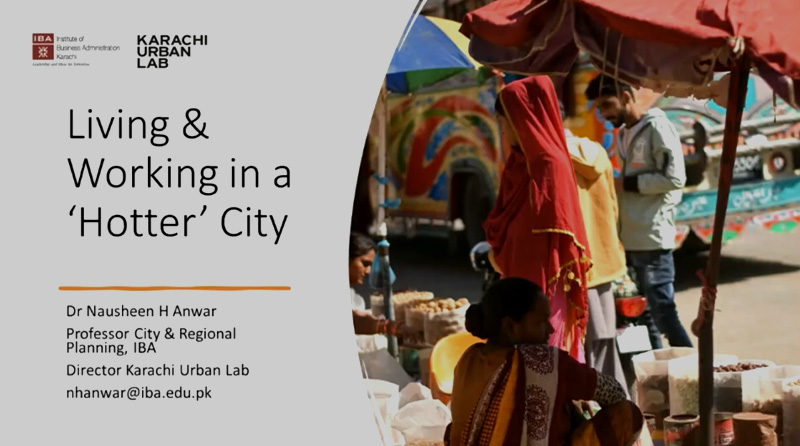Living and working in a hotter city
Event
Living and working in a 'hotter' city
Wednesday 18 May, 2022 – Wednesday 18 May, 20221:00 PM – 3:00 PM
Online
Part of the Hazard, Risk and Disaster (HRD) Research Lecture Series 2021-22.
Human activity has raised global temperatures by approximately 1.1 °C since pre-industrial times, and studies (Bazaz et al., 2018; Carrington, 2021) show nearly 70 percent of cities worldwide are impacted. The 6th Annual IPCC report on Climate Change (2021) has given somber warnings of global temperatures increasing up to 2°C by 2040, resulting in irreversible impacts. In regions such as South Asia, temperatures have already reached levels that are higher than what is considered biologically livable (Lewis, 2021; ADB, 2010; Mearnes & Norton 2009). According to the Global Climate Risk Index 2021, Pakistan is the eighth most vulnerable country in the world (Eckstein et al., 2021); and from a historical perspective, the country’s overall temperature has already risen by an average of 0.6°C (TFCC, 2010). A significant change is the increased frequency of days with intense heat: a five-fold increase in heatwave days per annum (TFCC, 2010). Pakistan's southern province of Sindh is understood as one of South Asia’s hotspots for global warming (Mani, 2018:10), and its largest city - Karachi - is rapidly warming at a rate of 0.4 °C/decade with daytime ambient temperatures often exceeding 35°C in summers that have also become longer (Abdullah, Anwar, Khan et al., forthcoming).
How does heat help us to understand and analyse social, economic and gender inequalities in cities impacted by rising temperatures? Across urban South Asia, changing climate and heat exposure are growing concerns and the burden of extreme heat exposure is unequally distributed and gendered. This was evident in Karachi where, in July 2015, a heatwave killed well over 1000 people- predominantly poor. In urban Pakistan, vulnerability to poverty often intersects with limited or poor access to critical infrastructures such as shade, clean water and uninterrupted electricity that are essential for cooling. In Karachi, well over 62 percent of the population (20 million) resides in informal settlements with unequal access to such infrastructures. Moreover, nearly 70 percent of the city’s population is involved in informal and precarious employment. Against the backdrop of inaccessible and shrinking green spaces, uneven access to water and electricity, informal workers such as street vendors, hawkers, daily wagers who work outdoors and are exposed to heat and solar radiation, must navigate their place in the city to find protection from heat and the sun. These navigations are mired not only in broader visions of ‘world class’ city making but also heat governance plans and actions that are shaped by planners' and policymakers' rigid understandings of heat.
About the speaker
Nausheen H. Anwar is Founder & Director of the Karachi Urban Lab (KUL) and Professor of City & Regional Planning, at the School of Economics & Social Sciences (SESS), Institute of Business Administration (IBA), Karachi, Pakistan. She also holds a joint appointment as a Senior Fellow with the Cities Cluster, Institute of Development Studies (IDS), University of Sussex, Brighton, UK. She received her PhD in City & Regional Planning from Columbia University, USA. Nausheen has held postdoctoral positions at Harvard University (USA) and at the Asia Research Institute (ARI), National University Singapore (Singapore).
Nausheen’s work focuses on the politics of urban planning, infrastructure development and climate change. She has authored a book: Infrastructure Redux: Crisis, Progress in Industrial Pakistan & Beyond (2015, Palgrave Macmillan), which explores, through detailed cases of Sialkot and Faisalabad in industrializing Punjab, the double-edged narratives of development that frame infrastructure in post-independence Pakistan. Nausheen’s current research involves 3 projects: the first is a GCRF funded 3-year comparative global study of human infrastructure interactions in the off-grid city, using heat as a lens to rethink vulnerability, marginality, and risk in the urban global South; the second is a GCRF funded 2-year knowledge network building project to promote new understanding and learning about the interactions between urban violence and climate change risks in urban areas of the global South; the third is a Canadian government International Development Research Centre (IDRC) funded 2-year project that examines new regimes of infrastructure planning and land acquisition/development and attended regional-urban transformations involving forms of displacement, resistance, and formal/non-formal pathways of redress in urban Pakistan.
Nausheen has published widely in academic journals such as Antipode, Urban Studies, South Asian History & Culture, EPW and Political Geography; and written articles for national and international media such as Dawn, Prism, MIT Technology Review Pakistan and Huffington Post. Nausheen is deeply committed to public outreach to advance the understanding of global-urban issues to foster the development of socially just and sustainable cities.
